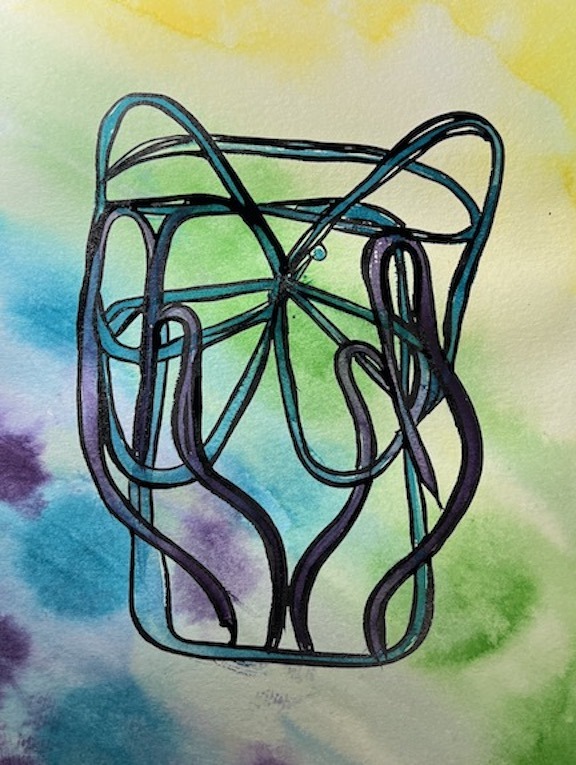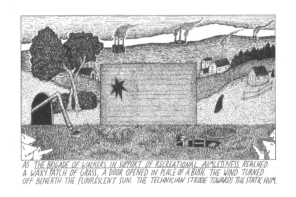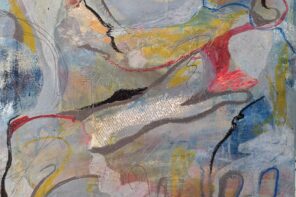When I read Jack Jung’s translations in Yi Sang: Selected Works (Wave Books, 2020), I felt the work was a breakthrough. I was immediately taken by the skill with which Sang’s thrilling difficulty, strangeness, and signature surrealism was rendered into English. In Selected Works, collaboratively produced by Jung, Don Mee Choi, Sawako Nakayasu, and Joyelle McSweeney, Jung’s critical acuity is obvious and the collection, which chronicles the ranging stylistic experiments that characterize Sang’s oeuvre, is a feat that offers a worthy example of the rewards of risk in the making—and translation—of poetry.
I was eager to meet with Jack to hear about his experiences executing this triumphant volume. Jack and I met over Zoom to talk about Yi Sang’s life and work, the aesthetics and histories that charge Selected Works, and Jack’s translation practice.
David Ehmcke: When you were first introduced to Yi Sang’s work, did you know that you’d come across something remarkable? What was the experience of encountering his work as a poet and possible translator, if that was even in your mind as you came across his work?
Jack Jung: I had two separate phases of being introduced to Yi Sang’s work. There was this Korean movie in the 90s that was based on Yi Sang’s work; it was kind of a Korean version of The X-Files, and they used Yi Sang’s poems as a kind of code for investigators to uncover some secrets. I remember watching the movie, but then it all went over my head. I was too young for that; I think I was in elementary school still. When I met Yi Sang again, it was right around my freshman year of college and I’d forgotten about the movie. Then I had this a-ha moment, like Oh gosh, it’s that guy from that movie. I remember in my poetry workshop with Jorie Graham, she was telling us that we need to find some poets that we might like to translate, if we had another language, because translation would be amazing for developing your poetry composition skills. I asked my mother, who was far more knowledgeable about Korean literature, “Do you have any poets that I should probably look at?” She showed me a bunch, and one of them was Yi Sang. I remember having my head blown off when I first read him. Those were poems such as “Flowering Tree,” “Cliff,” “Crow’s Eye View: Poem No. 1” and “Crow’s Eye View: Poem No. 2.” I’d say those are also his more accessible poems, and they are poems that are very obsessed and doing something special with repetitions—overbearing repetitions, something very claustrophobic with language, while also being this immediate release of our emotional energy.
At the time, I had a vague sense of what Yi Sang’s time, 1930s Korea, might have been like. I hadn’t studied much at all, even though I had a good grasp of Korean; after I came to the States when I was 13, I always spoke in Korean with my mother at home while continuing to develop my English skills at school. I thought I had to translate Yi Sang right away for that workshop and showed it to Jorie. She was incredibly excited about the poems and told me that I had to translate Sang. Translation quickly became no longer just a tool for learning about poetry composition but a mission right away. I started translating him, and throughout college I had worked on his Korean poems, there are about 50 of them. As I was studying English literature, translating Yi Sang was something I did on the side all the time. That first meeting was kind of the shotgun to my head because not only was he so different from anyone I had read up until that point, but it’s interesting for Korean Americans like myself who have very little opportunity to study the culture of their home country, to see these poets and writings. In that sense, it’s kind of like finding another aspect of identity that you didn’t know could be a part of you. I think that was also important to me. Especially when I had only been reading English and American writers who were, you know, mostly white.
DE: Now it’s been about a decade that you’ve been translating Yi Sang. What have you found continues your devotion or keeps translation just as nourishing or exhilarating? Or is translation an obsession that you can’t stop?
JJ: I remember watching this taped lecture of Seamus Heaney some time ago, and he was talking about translating from Old English. What I remember is he was talking about how translation is like a finding a path again, or it’s like shadow boxing with what has already been accomplished, but you’re trying to find that gold, that treasure, in your own path. That gold has been found for you, and you are trying to get there with your own language. Translation’s not easier than creating something out of nothing because sometimes you fail to get to that gold through your process. And that’s even more disheartening. But trying to reach this sensation and enlightenment and sometimes despair through your own language can be exhilarating. It’s like meeting someone that’s on the page in a completely different light. I think anyone who is a lover of close reading any kind of text would find translation the greatest method for close reading and the pleasures you can get from it.
DE: What are some of the idiosyncratic difficulties of translating Yi Sang?
JJ: Yi Sang was a rule-breaker. For instance, his sentences in original Korean do not use what’s called a spacing rule. In Korean it’d be called ddeui-eo sseugi (띄어쓰기). And these rules were adopted into Korean in modern times, before Yi Sang was born, to make it easier for readers to comprehend where the clauses ended and began in a sentence. Yi Sang does away with it completely, so that everything feels very compressed and claustrophobic. It’s something spoken almost out of anguish. What makes that possible—this lack of any spaces between words and clauses in Korean and other East Asian languages—is that everything is in blocks. So, every character or every syllabic unit is also in blocks. For instance, in any kind of Chinese poetry, you see a bunch of characters, and those are blocks and each of the characters have individual sounds. So even if you don’t have space, you can read it, and you can read the sound out loud very quickly. Perhaps you might not be able to read silently right away, but if you read it out loud, you see what the sentence is saying. When I tried that the first time in English, I realized that doesn’t happen at all for the Latin alphabet. You don’t know where the word ends and begins. It takes much longer to figure out where the sound is supposed to go. It does happen eventually, but what I felt was important was the howling that was happening in Korean. In English, the lack of spacing became an incredibly unexpected slowing-down and sometimes incomprehensibility. The choice I made was tokeep the spaces throughout Yi Sang’s poetry, and most of those are prose poems.
Yi Sang’s diagrams were not as difficult to translate, since those visual images can stay the same. Other than the fact that many of the original Yi Sang works were written in a vertical manner, whereas now, even in Korea, most writings are printed horizontal, as with English. Perhaps the way the shapes are felt in that original Korean might get lost in translation as well. Someone once told me about how the way the vertical lines are set in poems like “Crow’s Eye View” feels like rain and reminded them of falling codes from The Matrix when Neo sees the world in all those codes. And I thought, Well, that’s an interesting way to look at it. Those kinds of visual experiences get lost when you change orientation. But what I eventually concluded was that I wanted my interpretation of these poems to come through. For me, translating Yi Sang, first and foremost, is about making it clear how his images and figurations are unfolding on the page and that they become as clear as possible for an English reader. I’ve been told by a Yi Sang scholar that reading Yi Sang like this in English will be far more accessible because in the original Yi Sang uses literary Chinese characters that were already out of usage in his time. He takes old words and dusts them off to use in his very radical, avant-garde forms. That same scholar told me, “How about translating some of these words into Latin so that their difficultly comes across?’’ A little bit extreme, I thought, I don’t think I’m going to do that. But, the immediate experience of feeling like these texts are obscure and opaque is gone in my English versions. I wanted for readers in English to have direct access to the experience of what is happening in the sense of the images that are unfolding in Yi Sang’s poems.
DE: It really underscores how, as the translator, you’re approximating both linguistic precision and precision of feeling—that somatic response to estrangement—at the same time. That was an intriguing suggestion that the Yi Sang scholar gave you about Latin.
One thing you brought up in your Poetry Society of America essay is the reception of Yi Sang’s first poem by the national lyric poet Jung Jiyong, who said, “Our country needs at least one person who writes such weird poems.” What does it mean that this body of experimental work is preserved—that there are stewards for this—and that experimental poetry as a project exists ubiquitously?
JJ: That’s a really good question. It’s interesting because the man who said how weird these poems are and how it might be necessary for our country to have one weird poet—Jung Jiyong—was himself very experimental. He is considered a modernist and especially his early poems feel like Yi Sang’s poems in some cases, with their interactions with cityscapes and people lost and wandering in a wasteland of modern cities. Yi Sang himself also really loved Jiyong’s poetry. Yi Sang eventually founded a literary group with Jiyong and other like-minded writers, and they called themselves Guinhoe (구인회), which translates to “Circle of Nine,” or “Society of Nine,” because there were just nine members. They all met at Yi Sang’s café called “Jebi,” named after a bird, swallow, in Korean. Later on, after the liberation and after the Korean War, there was a period where those poets were judged quite harshly for not being much more active and much more outrightly resistant of the empire as public intellectuals. Some would go so far as calling it a neglection of their duty as poets and writers. Others would say that those poets and writers were fascinated and in love with the modernism from the West, that they were just trying to reach that Western ideal they could never achieve and failed. But I think that their experimental decadence and the excess in their writing was, in fact, essential, because in response to the calamitous nature of their time they were creating a world of their own, their own small festival.
The poems within that circle become very self-referential; they are talking about each other, their short stories are talking about each other, and their poems are universes of their own. I think you might have seen that in Yi Sang’s poetry as well, the way his motifs—a mirror, a butterfly, a girl, etc.—make their way in. The avant-garde was, for them, their way of keeping their humanity in that harshest of climate. I also think breaking the language itself became most important to them. In a way, it’s not only creating their own space of freedom within a horrible reality but also about leaving a record for the future. Experimental decadence is not a choice that you make to escape from reality; it’s a necessary reaction to that reality.
DE: You also mentioned being energized, at least early on, by Yi Sang’s closing gestures, especially in the prose poems; it seems like in those closing gestures there’s a refusal of finitude. The nature of these poems is elliptical; there’s a reaching beyond the bounds of the form even after the poem has ended, which also seems a commentary on or capturing of the fragmentation and political violence associated with the conditions in which Yi Sang was living. I was wondering if you could comment on how Yi Sang’s poetry metabolizes or reacts to the conditions of his life.
JJ: That’s true especially of his poems that were originally written in Japanese, and that Sawako Nakayasu translated beautifully in our volume and were published in a Japanese language publication called Joseongwa Geonchuk (조선과 건축), which translates as “Korea and Architecture.” It was an architectural magazine. Many of those poems didn’t go through any kind of rigorous censorship and therefore could express certain things much more directly. One of the poems from that period of Yi Sang’s writing is titled “Publication Law.” In that poem, Yi Sang parodies how columns or how an essay might have these random sections redacted without any kind of explanation. He puts in these spaces that are redacted and that are changed, but it’s parodying the publication law rather than having the publication law being imposed on his poem. There were things he did visually and typographically. In Sawako’s translations, the “Memorandum on the Line” poems, you see Yi Sang have a jumping-off point for Einstein’s relativity theory, and time travel becomes a main theme in poems about traveling at the speed of light and going through the future and meeting different selves. It’s speculative poetry. Yi Sang was not only writing in reaction to his time, but he was bringing in a lot of recent discoveries in technology and science to use as metaphors and to challenge the language, like in the poem “Crow’s Eye View: Poem No. 8 ‘Anatomy,’” in which he uses the language of an X-ray technician. He closes the gap between poetic language and the language of technology. I think this was his way of saying that the modernity that’s upon us as Koreans is both what’s oppressing us and what’s seducing us.
DE: It’s fascinating because there’s terminology that’s on the cutting edge of modernity, yet, as you say earlier, there’s also the recurrence of antiquated language, and I wonder if it reveals a disposition toward modernity or, considering the surrealism of Yi Sang’s poetry, toward rationalism that creates apertures in rational temporality. You say that lovely phrase “speculative poetry”; it goes back to this notion of imagining forms of living or forms of freedom. You have to create fissures or apertures in time in order to exceed or proceed beyond the modernity one inherits from unlivable circumstances.
JJ: Yi Sang’s stories and poems are very much his despairs about not being able to find a certain type of authenticity, and that’s not necessarily authenticity in the way we use it. He despairs over things being copies—and copies of copies—like in a poem called “Self-Portrait.” There was “deconstructionist” thinking in motion in Yi Sang’s mind—thinking of Japan’s modernism and imperialism as a copy of Western modernism and imperialism. I think what Yi Sang wanted to do with his poetry is motion his lines into a kind of release, a heightened state of awareness. Another way of reading Yi Sang’s work, some have speculated, is to see the poems as fragments of a greater opus that he had in his mind, something that he had no time to finish constructing. A great tower; it’s a ruin that we are witnessing. We may have to piece the work together to truly find what Yi Sang’s concept of humanity and humanism is. We have to cobble together these leftover ruins after all the calamities of the 20th century.
DE: I love this idea of the ruins because Yi Sang was, of course, trained as an architect. Going back to the motivating device of the motif in Yi Sang’s work—the mirrors, butterflies, girls, mathematics, medicine and doctors, circles, circularity and circuitousness—as a translator, do you think Yi Sang is creating a recurring symbology or vernacular of images in a coherent way, one that is intertextually woven? What do you make of the motifs?
JJ: Yes, exactly. He creates an intertextually woven, self-referential universe through his poetry. Some would argue that these images are keys to the kingdom of Yi Sang’s secrets. I’m not sure if we can completely unlock what he is doing with those images, but what it does do—going back to that earlier talk about ruin and fragments—is allow us to see Yi Sang’s work as not just individual poems but as a great singular work. Yi Sang’s life and all his poetry, essays, and short stories have, for lack of better term, novel-like details that bounce off each other. I do think Yi Sang, had he had more time, would have been much more involved in fleshing out this intertextuality too. The reason I think he does this is, first, out of the necessity to create a world apart from the world where he can experiment with subjectivity, perspectives, and many other things. Figures like butterflies may come from Taoist texts or certain European texts, and the mirror may be coming from outside of Yi Sang’s world as well, but Yi Sang is building his own mirror and he’s trying to create his own butterfly. He’s building on these images to create his own voice and to discover his own definition of universal and sometimes dangerously cliché images. It’s like a master trying to sign his name on the world.
DE: He is an oracular poet. And I feel that although his work was cast off while he was alive, it coheres with our present moment in a way that is quite resonant. What is your impression of the significance of Yi Sang’s work today? Have you been surprised by the contemporary response to Yi Sang?
JJ: I think that what Yi Sang does for a lot of people is get into the heart and mind at the same time. You end up thinking feelingly, if that makes sense. Another thing I would say is Yi Sang has an unexpected echo in our time that’s almost frightening. That’s why I think some of his poetry now speaks to the harrowing truths of today. What I also find helpful in reading Yi Sang is that his poems are about trying to maintain your own freedom within your own universe. To see that in poetry—and to see that as a record in poetry—speaks volumes as someone who is trying to write poetry: the insistence on freedom at a time when the world was very much uninterested in it.
David Ehmcke is the poetry editor of The Spectacle. He is an MFA candidate in poetry at Washington University in St. Louis, where he reads and works for Dorothy, a publishing project.
Jack Saebyok Jung studied at the Iowa Writers’ Workshop, where he was a Truman Capote Fellow. He is a co-translator of Yi Sang: Selected Works (Wave Books, 2020), the winner of the 2021 MLA Prize for a Translation of Literary Work. He teaches at Davidson College.
Yi Sang (이상) (1910-1937) was one of the most important Korean avant-garde writers of the Japanese colonial era. Trained as an architect, he is known especially for his long poem “Crow’s Eye View” and his short story “The Wings.” The Yi Sang Literary Award, one of Korea’s most prestigious literary prizes, is named in his honor. He died in Tokyo from complications of tuberculosis following his arrest by Japanese authorities for suspected ideological crimes against the Empire of Japan.




